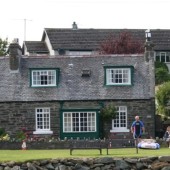History and Heritage
The following paragraphs are intended to give the reader just a taste of the rich heritage of the Tayvallich area.
In 1966 the Tayvallich branch of the Scottish Women's Rural Institute published a booklet "Our Village History". It was reissued in 1989, but is now out of print. The SWRI has kindly allowed us to reproduce it in full on the website.
Early settlement
The first settlers, or immigrants probably came to this area about 10,000 years ago, after the end of the ice age. Later settlers took up residence, tilled the land and kept livestock for clothing and food ( skins and meat).
Raiding was commonplace, so forts or "duns" were built in which livestock was kept, and from which people could defend themselves and their animals.
Later, after Christianity came to Iona by St Columba, priests took up residence on islands, and lived in cells.
Vikings came too. They built Castle Sween, and kept their longboats between the island of Danna and Ulva.
By the Seventeenth Century, landlords had acquired small estates, Danna, Ulva and Taynish etc. By 1770, most of these small estates had been combined by purchase, and there were only three estates at Tayvallich - The Ross estate, Keills estate, and Carsaig estate.
Occupations
In the 19th century farming was the most important occupation. Potatoes were exported to Ireland from Port Nan Gallon. The Oakwoods of Taynish were coppiced. The timber was used for making charcoal and the bark for tanning. Some say the charcoal hearths were early hut settlements.
There was a distillery at what is now Carsaig Farm (now converted for living accommodation) which made Naphtha, a form of wood alcohol from birchwood.
Fishing was mainly carried out for domestic consumption, with surplus fish being salted for winter use. Commercial fishing has only been undertaken during the last twenty or so years. Oysters were cultivated in Linne Mhuirich for consumption by Poltalloch and Ross estates which shared the lease of the seabed. Later some oyster and mussel farming was undertaken on a fairly small scale for commercial purposes (1960s).
Drove Roads
Cattle were ferried from Jura to Keills in open boats (19th Century) and then driven north through Tayvallich to the trysts (cattle markets) at Kilmichael Glassary. The cattle were then taken on to Falkirk. Cattle were still driven to the Lochgilphead Market ( now Jewsons builders yard) until the mid 1950s. There were inns, for the drover's refreshment, at Keillmore, Tayvallich, Arichonan and Bellanoch. The farmers returning from the trysts had to beware of highwaymen who would be on the lookout for those who had too much to drink and a good purse!
Superstitions
There were many old superstitions in the area. One held that cattle were protected from the "evil eye" by putting a piece of metal, usually a blunt needle, on a string which was tied to the horn of the Queen (or leading) cow. It was felt that a stranger passing by and looking at the animals for longer than just a glance might bring bad luck to the owner or lameness to the animals.
Witches operated a protection racket. Drovers passing their house would have to give the old woman a gift, usually of silver, to ensure a good sale and a safe journey. Failure to comply would mean cattle going lame or sick and a poor price at the tryst,
A wandering light seen along a road at night would foretell a death in the community.
Geology
Geologically, Tayvallich and the surrounding area lives mostly on Dalriadan quartzite with epidiorite and hornblende schists, and some bands of limestone and black slate.
We are on a fault that runs north east and south west, down which earth tremors sometimes occur. Two were recorded in January 1927, one in 1936. Others have been felt by inhabitants at later dates, one during World War 2, one in 1949 and at least two others in the late 1990’s one centered near the Island of Arran and the other near the Island of Islay. Fortunately there are no reports of any bottles of having fallen from the gantry of The Tayvallich Inn in any of these incidents and while we accept no responsibility for the advice, the fault line does not seem to present any exceptional hazard to the visitor.
The soil is very acid and is largely peat, though less so where the limestone shows itself. This is mostly on Danna where there was at one time a limekiln, the stone being worked and lime burnt there mostly for sale in the Western Isles.
Click here to Discover the nature story of Knapdale by connecting its rocks and landforms to the plants and animals. Please find more information at http://www.scottishgeology.com
We at Tayvallich.Com would welcome any contributions from student or professional geologists on this section of our site.








_baef36edc53bdd009ca06069d3b23fda.jpg)





